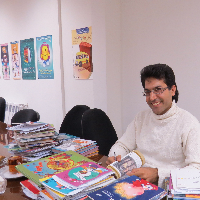The Three-Dimensional Interaction of “Title” in the Cover Design of Three Children’s Picture Books
In children’s literature, the title functions beyond mere labeling for identification purposes. Rather, the titling itself serves a linguocognitive role. Titles are viewed before the book is opened, thereby they can convey aesthetic significance by employing strategic typographic techniques that visually preview a book’s tonal direction. The intentional typographic design choice in formatting the title graphically depicts the relative conceptual space the book will inhabit. Additionally, the interaction between the formatted typographic title presentation on the front cover and the illustrative cover imagery contributes an essential role in coalescing the intended holistic cover design impression.This research aims to closely investigate the three-way interaction occurring between “title” (defined here as the linguistic facet encompassing the verbal meaning of the printed title text), “typography” (defined here as the aesthetic facet encompassing the graphical formatting and styling of the printed title text) and “cover image” (defined as the illustrative artwork encompassing the pictorial depiction on the front book cover) within the conceptual structure underlying the unified cover design presentation. The research methodology enacted is applied in nature, based fundamentally in library data collection, and analytical-descriptive in its systematic approach. The target domain under examination focuses exclusively on children’s picture storybooks classified for age groups “A” and “B,” while concentrating deliberate analysis specifically on three recently published titles selected expressly for their diversity exhibited in typographic title formatting and styling choices implemented: The Big Question (Erlbruch, 2009), Wise Honey (Piumini, 2017), and Sun Detective (Bahari, 2017).Unlike former studies pursuing a one-dimensional correlation between title and cover image, this research proposes a two-dimensional identity operating within the functional book title itself. It explores the complex three-way interaction by closely examining how the linguistic reading aspect, aesthetic/graphical typographic aspect, and illustrative cover image aspect relationally interconnect across all three domains through a conceptual triangular dialogue.The book title, like any other written sign, has both a visual and a reader-oriented aspect. This research demonstrates that these two aspects not only individually interact with the cover image but also have internal interactions with each other. Factors such as font size, color, thickness, and font type (visual aspect) can internally interact with the linguistic meaning of the title (reader-oriented aspect). Thus, the cover design results from the triangular relationship of the "reader-oriented aspect of the title," the "visual or typographic aspect of the title," and the "cover image."This triangular relationship initiates with a dual interaction, such as decoding based on the internal interaction of the title (reader-oriented and visual interactions) and subsequently using the decoded information as an introduction for deciphering the codes of the cover image. The diversity in visual structures and themes of each artistic work continues to revolve around a central theme. In each interaction, the main visual structures engage in semantic and interpretative interaction, followed by the sequential interaction of other visual elements in the triad of "title," "typography," and "cover image."
-
A Formalist Thematic Reading of Love in Reza Mouzuni’s “The Ice That Fell in Love with the Sun”
Amirhossein Zanjanbar *
Literary Theory and Criticism, -
Formalist devices in the Typography of Picture Books for Age Groups "A" and "B"
Amirhossein Zanjanbar *
Interdisciplinary research in persian Language and literature,



